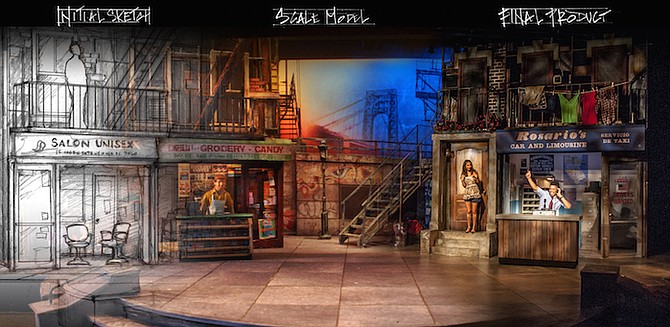 Facebook
Facebook
 X
X
 Instagram
Instagram
 TikTok
TikTok
 Youtube
Youtube

I’ve been asking veteran actors to name five dream roles and say why. It’s time to expand the category and ask theater designers and directors their dream projects. The answers not only reveal aspirations, they may put an idea in the minds of artistic directors and producers — even choices that seem outside the box.
Scenic designer Sean Fanning:

“I’ve been lucky enough to see a lot of my bucket-list shows fulfilled over the last decade or so in San Diego. People think I’m attracted to shows with complex sets and moving parts. But not always. Really, it’s the challenge and power of the material that makes me fall in love with productions.”
1) A Streetcar Named Desire, by Tennessee Williams. “It’s been on my bucket list since I started designing. Elia Kazan, the original director, called it a ‘poetic tragedy,’ but I think it lives in that place where poeticism meets realism. I imagine a vivid physical environment that blends elements of the two. It would be a set reinforcing the contrasts of the characters: the deteriorating aristocracy of the South (Stella), the working-class, brutish masculinity of the everyday (Stanley), and the delusional inability to surrender to a shifting reality (Blanche).”
2) Chicago, by Kander and Ebb. “I love the way it satirizes show business, media, and how we create celebrity out of the criminal — and does so through a series of vaudeville acts. Chicago uses show business as a metaphor for life, so I would place this show in a Prohibition-era vaudeville house and embrace the original spirit in which it was written — with a tightly controlled color palette of crisp black-and-white and hand-colored sepia tones, as if the whole thing has been soaked in bourbon.”
3) 1776, by Sherman Edwards and Peter Stone. “One of my favorite musicals of all time. It’s got a great book, and I’m a sucker for history. It’s such an important story to put on stage, and I’d love to create a sense of how significant this event was. The set is not complicated: I imagine recreating the Continental Congress chamber using paintings of the era, and perhaps break it apart in a lively way, transitioning to the street outside poetically with sliding or flown slatted or scrim walls.”
4) Long Day’s Journey into Night, by Eugene O’Neill. ”A modern tragedy of tortured love veiled by family dysfunction and addiction. The setting is the Tyrones' summer home in Connecticut. I picture it as a ghost of the home that once was, a hollowed-out, wooden shell that feels barely lived in and perhaps contains only fragments of memories, hints of architecture. Most present is the nearby sea, the sense of fog sweeping into this space and leaching into the paneling, and diffused light forcing its way into the windows.”
5) Oliver!, by Lionel Bart. “I love the dark escapism and the seedy opportunities in this production. Going back to the 1836 George Cruikshank illustrations of London as a jumping-off point, I would use combinations of faux and overly painted scenery with 3D but rough, elemental stagecraft to tell the story. It would be wonderful to use Victorian stage conventions such as a painted show curtain, visible rigging, and footlights to transport the audience to this time period.”


I’ve been asking veteran actors to name five dream roles and say why. It’s time to expand the category and ask theater designers and directors their dream projects. The answers not only reveal aspirations, they may put an idea in the minds of artistic directors and producers — even choices that seem outside the box.
Scenic designer Sean Fanning:

“I’ve been lucky enough to see a lot of my bucket-list shows fulfilled over the last decade or so in San Diego. People think I’m attracted to shows with complex sets and moving parts. But not always. Really, it’s the challenge and power of the material that makes me fall in love with productions.”
1) A Streetcar Named Desire, by Tennessee Williams. “It’s been on my bucket list since I started designing. Elia Kazan, the original director, called it a ‘poetic tragedy,’ but I think it lives in that place where poeticism meets realism. I imagine a vivid physical environment that blends elements of the two. It would be a set reinforcing the contrasts of the characters: the deteriorating aristocracy of the South (Stella), the working-class, brutish masculinity of the everyday (Stanley), and the delusional inability to surrender to a shifting reality (Blanche).”
2) Chicago, by Kander and Ebb. “I love the way it satirizes show business, media, and how we create celebrity out of the criminal — and does so through a series of vaudeville acts. Chicago uses show business as a metaphor for life, so I would place this show in a Prohibition-era vaudeville house and embrace the original spirit in which it was written — with a tightly controlled color palette of crisp black-and-white and hand-colored sepia tones, as if the whole thing has been soaked in bourbon.”
3) 1776, by Sherman Edwards and Peter Stone. “One of my favorite musicals of all time. It’s got a great book, and I’m a sucker for history. It’s such an important story to put on stage, and I’d love to create a sense of how significant this event was. The set is not complicated: I imagine recreating the Continental Congress chamber using paintings of the era, and perhaps break it apart in a lively way, transitioning to the street outside poetically with sliding or flown slatted or scrim walls.”
4) Long Day’s Journey into Night, by Eugene O’Neill. ”A modern tragedy of tortured love veiled by family dysfunction and addiction. The setting is the Tyrones' summer home in Connecticut. I picture it as a ghost of the home that once was, a hollowed-out, wooden shell that feels barely lived in and perhaps contains only fragments of memories, hints of architecture. Most present is the nearby sea, the sense of fog sweeping into this space and leaching into the paneling, and diffused light forcing its way into the windows.”
5) Oliver!, by Lionel Bart. “I love the dark escapism and the seedy opportunities in this production. Going back to the 1836 George Cruikshank illustrations of London as a jumping-off point, I would use combinations of faux and overly painted scenery with 3D but rough, elemental stagecraft to tell the story. It would be wonderful to use Victorian stage conventions such as a painted show curtain, visible rigging, and footlights to transport the audience to this time period.”
Comments